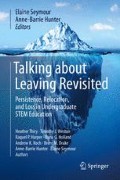Abstract
This chapter explores the relationship among students’ preparation for college-level STEM coursework, their transition into undergraduate studies, and attrition from STEM majors. Nearly one-third of students were underprepared for advanced STEM coursework and this directly contributed to switching decisions for about half of these students. Students of color were more likely to feel that they were poorly prepared in math. Women of color, in particular, were most likely to attribute their decision to switch to a lack of STEM preparation. Many underprepared students had experienced poor teaching in high school or a rote curriculum that did not emphasize abstract or conceptual learning. Some students were also unprepared for the workload, organization, and time management required in undergraduate STEM courses. Lack of preparation and a difficult transition to college often coupled with other factors that ultimately contributed to students’ decision to leave STEM.
Access this chapter
Tax calculation will be finalised at checkout
Purchases are for personal use only
References
Belfield, C. R., & Crosta, P. M. (2012). Predicting success in college: The importance of placement tests and high school transcripts (CCRC Working Paper No. 42). Community College Research Center, Teacher’s College, Columbia University.
Bonous-Hammarth, M. (2000). Pathways to success: Affirming opportunities for science, mathematics, and engineering majors. Journal of Negro Education, 69(1/2), 92–111.
Chang, M. J., Cerna, O., Han, J., & Saenz, V. (2008). The contradictory roles of institutional status in retaining underrepresented minorities in biomedical and Behavioral science majors. The Review of Higher Education, 31(4), 433–464.
Crisp, G., Nora, A., & Taggart, A. (2009). Student characteristics, pre-college, college, and environmental factors as predictors of majoring in and earning a STEM degree: An analysis of students attending a Hispanic-serving institution. American Educational Research Journal, 46(4), 924–942.
Eagan, M. K., Hurtado, S., & Chang, M. J. (2010, November). What matters in STEM: Institutional contexts that influence bachelor’s degree completion rates. Paper presented at the annual meeting of the Association for the Study of Higher Education, Indianapolis, IN.
Ferrare, J. J., & Miller, J. M. (2019). Making sense of persistence in scientific purgatory: A multi-institutional analysis of instructors in introductory science, technology, engineering, and mathematics (STEM) courses. Journal of Higher Education. https://doi.org/10.1080/00221546.2019.1602392
Gayles, J. G., & Ampaw, F. (2014). The impact of college experiences on degree completion in STEM fields at four-year institutions: Does gender matter? The Journal of Higher Education, 85(4), 439–468.
Oakes, J. (2005). Keeping track: How schools structure inequality (2nd ed.). New Haven, CT: Yale University Press.
Price, J. (2010). The effect of instructor race and gender on student persistence in STEM fields. Economics of Education Review, 29(6), 901–910.
Rask, K. (2010). Attrition in STEM fields at a liberal arts college: The importance of grades and pre-collegiate preferences. Economics of Education Review, 29(6), 892–900. https://doi.org/10.1016/j.econedurev.2010.06.013
Riegle-Crumb, C., & King, B. (2010). Questioning a white male advantage in STEM: Examining disparities in college major by gender and race/ethnicity. Educational Researcher., 39(9), 656–664.
Rubin, B. C. (2003). Unpacking detracking: When progressive pedagogy meets students’ social worlds. American Educational Research Journal, 40(2), 539–573.
Seymour, E., & Hewitt, N. M. (1997). Talking about leaving: Why undergraduates leave the sciences. Boulder, CO: Westview Press.
Author information
Authors and Affiliations
Corresponding author
Editor information
Editors and Affiliations
Rights and permissions
Copyright information
© 2019 Springer Nature Switzerland AG
About this chapter
Cite this chapter
Thiry, H. (2019). Issues with High School Preparation and Transition to College. In: Seymour, E., Hunter, AB. (eds) Talking about Leaving Revisited. Springer, Cham. https://doi.org/10.1007/978-3-030-25304-2_5
Download citation
DOI: https://doi.org/10.1007/978-3-030-25304-2_5
Published:
Publisher Name: Springer, Cham
Print ISBN: 978-3-030-25303-5
Online ISBN: 978-3-030-25304-2
eBook Packages: EducationEducation (R0)

